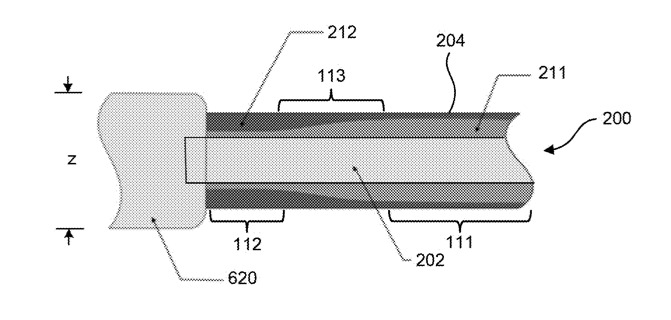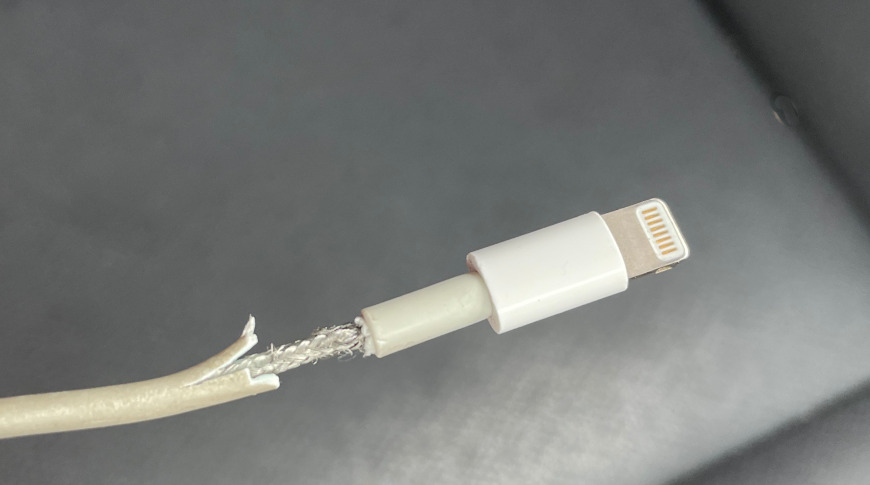If you've ever had an iPhone Lightning cable in your car, you already know how fragile they are. Apple may now have a solution that could also protect any kind of cable.
Apple is never going to say that Lightning cables have a death wish, but it has come close in a newly revealed patent application that is really about fixing the problem. "Cable with Variable Stiffness," does not mention Lightning once, nor does it say anything approaching the word "frayed."
"It is well known that bending of the cable near the termination point may cause unwanted strain on the wire connections, which may lead to cable failure," it admits. "Accordingly, it is common to provide a strain relief sleeve made of a stiff material around the end region of the cable."
Apple's descriptions apply to many types of cable, and so do its criticisms of current solutions.
"The stiff material creates a localized increase in the bending resistance of the cable, thereby relieving strain on the wire connections," it continues. "In addition to making the cable locally stiffer, the strain relief sleeve also makes the cable thicker at the ends. In some instances, the added thickness may not be desired."
If you've been using Apple gear for long enough, you may remember how Apple slightly thickened Lightning cables. It presumably meant they were a little less prone to damage. As a side-effect, it meant that they sometimes no longer fit in channels machined into iPhone stands by third-party manufacturers.
Apple's new proposal is a development of both the "strain relief" idea, and the extra thickening of cables overall. "A cable can include a cable core surrounded by an outer sleeve having a uniform thickness," says the patent application.
"[It further has] a first longitudinal section having a first stiffness (e.g., corresponding to a flexible cable), a second longitudinal section having a second stiffness (e.g., corresponding to a rigid cable), and a third longitudinal section between the first and second longitudinal sections," says Apple.
 Detail from the patent application showing one combination of layers of cable and protective covering
Detail from the patent application showing one combination of layers of cable and protective coveringThe first cable has some unspecified certain degree of stiffness, while the second is more stiff. And the "stiffness of the third longitudinal section varies between the first stiffness and the second stiffness." Really what this does is extend the "strain relief for the cable."
The majority of the patent application describes different possible materials, and also attempts to define stiffness. "For example, minimum bend radius, defined as the smallest radius at which the cable can be bent without a kink, is one well-known measure of cable stiffness," says Apple, "and a minimum bend radius can be defined relative to the cable diameter."
"Increasing bend radius corresponds to increasing stiffness. Depending on the particular cable design, the minimum bend radius might be e.g., 8 to 12 times the cable diameter," it continues.
The patent application is credited to seven inventors, including Christopher S. Graham. His previous related work includes granted patents regarding "shielding for multi-coil wireless power transfer systems," and "wound housings for electronic devices."
 William Gallagher
William Gallagher







-m.jpg)






 Andrew Orr
Andrew Orr
 Malcolm Owen
Malcolm Owen


 Wesley Hilliard
Wesley Hilliard







-m.jpg)




52 Comments
I've owned an iPhone since the 3G model and never had one of my Apple branded Lightning cables fail. My opinion is that people just abuse them. On the other hand, Apple should probably realize that this is going to happen, and take that into account with a more robust design.
I have repaired a couple at the office using heat-shrink sleeving to provide extra strain relief. Works fine, cheap and easy to do.
I don't believe the bullshit about Apple’s cables. I’ve been using Apple cables and dongles for a decade and have never, EVER, had one fray or fail on me. I’ve never heard a complaint for my extended family about them either. To me this is yet another example of internet amplification of an issue. And if Apple cables do have a real problem then all cables from all manufacturers do too. The article even states that, "It is well known that bending of the cable near the termination point may cause unwanted strain on the wire connections, which may lead to cable failure”. Yes, it’s well known in the entire cable industry and has been for almost a century of electrical connections, wiring, etc.
Great if Apple is looking at the problem but this is an industry problem, not just an Apple problem. So stop with the “Apple cables are crap” nonsense. They are no better or worse than others when the user yanks, bends, twists or otherwise abuses a cable.
I have never had a 30-pin or lightning cable fail, ever. There are absolutely people who are not careful or responsible with their things, and the possibility of accidents causing cable damage.
Why it took this long for Apple to realize that overtime cable is working but slowly do start tearing off, go bad at termination. Happened to many many customers. Also, one culprit to higher numbers is millions of knock-off low quality cheap cable sold as Apple product(on Amazon,eBay,etc) which added fuel to the fire and users think Apple cable went bad. Because of this, companies like Anker,Amazonbasics,etc made MFi approved stronger charging cable and made lots of money.
What do these people do to the cables, chew on them?!